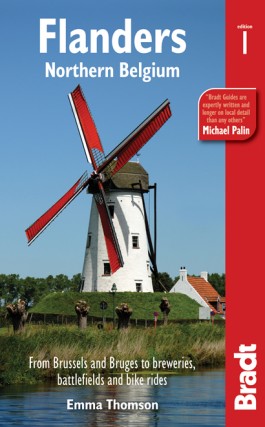
Flanders – Northern Belgium
By Emma Thomson
Bradt Guides – £15.99
According to Michael Palin ”Bradt Guides are expertly written and longer on local detail than any others,” which, at the end of the day, I cannot help but agree with.
Having recently spent a fair bit of time in the Zeebrugge area of West Flanders, I was looking for a guide book that would indeed shed assorted, if not detailed light on some of surrounding area(s); primarily that which could be reached via the coastal tram which runs from one end of the Belgium coast to the other.
Beginning in Knokke-Heist near the Dutch border, said Kusttram runs the entire 68 km (42 miles), all the way to De Panne – which nigh touches the French border. As the authoress Emma Thomson writes in chapter six (‘West Flanders’): ”De Lijn operates a cheap-as-chips (or should that be frites?) tram service that visits over 70 destinations […]. Trams run every 20 minutes during winter and every ten minutes in summer.”
Whilst in Zeebrugge, I do have to say, De Lijn was my gateway to the coast, which in and of itself, incorporates a menagerie of quaint seaside towns. One I invariably visited was Blankenberg, on which Thomson writes: ”Blankenberg is to Flanders, what Blackpool is to north-west England. During summer, the coast’s second largest town is filled with noisy bars and restaurants and it’s 350m-long seafront crowded with people. It’s not everyone’s cup of tea, but it’s a good place for kids thanks to a clutch of animal-themed attractions and the huge range of sports on offer.”
To be honest, I’m not entirely sure I agree with the Blackpool comparison – there’s no-where near as many loud-mouthed, Jeremy Kyle types, while the streets aren’t paved with puke. That said, I do rather like the fact that Flanders – Northern Belgium didn’t skirt around the area, if not avoid Blankenberg altogether – like so many other Belgian guides.
To be sure, there was even a ”what to see and do” section on the (small) town – replete with phone numbers, addresses, prices and hours of opening. A mighty handy check-list that is a feature running throughout these 338 pages (excluding colour photographs, Author’s Story, Acknowledgements, List of Maps, Introduction, Appendix one to four and Index) as a whole.
So in all, the aforementioned Palin is right in stating that Bradt Guides are ”longer on local detail than any others.”
Along with a friendly tonality of writing – which essentially endeavoured to pin-point what one (usually) always wants to know – I found this particular guide more than helpful and informative.
David Marx

